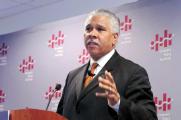THE WORK THAT REMAINS
A joint presentation of the Milton S. Eisenhower Foundation and the Economic Policy Institute

On November 13, 2008, in collaboration with the Eisenhower Foundation, EPI presented a forum to assess our nation’s progress over the forty years since the Kerner Report was issued and, more important, to discuss what is still left to do to move us closer to an equal and high-performing society, with a specific focus on establishing an economic policy that works for everyone.
Click here to read a Viewpoint by EPI Staff Writer Abby Rapoport.
Introduction
CHRISTIAN DORSEY
Outreach Coordinator, Economic Policy Institute
Forty years ago, the National Advisory Commission on Civil Disorders, also known as the Kerner Commission, famously concluded that America was "moving toward two societies, one black, one white--separate and unequal." Its recommendations to promote racial integration and remedy the economic failures that fostered a wave of inner city violence were ultimately rejected by President Lyndon Johnson, who appointed the commission. Today, minorities still face many of the troubling conditions outlined in the commission report, including under-representation in the labor market, high rates of poverty, disparities in education funding and disproportionate involvement in the criminal justice system.
Opening remarks
DR. VALERIE RAWLSTON WILSON
Senior Resident Scholar, National Urban League Policy Institute
Addressing issues central to Black America, Dr. Wilson spoke on the conditions, experiences and opinions of Black America. She looked at progress in key areas of particular interest in todays economy, such homeownership, jobs and health. She discussed a set of recommendations proposed by the National Urban League.
Click here to read the National Urban League's Opportunity Compact: Blue Print for Economic Equality
DR. ALAN CURTIS
President and CEO, Eisenhower Foundation
The Kerner Commission concluded that it was "time to make good the promises of American democracy to all ciizens - urban and rural, White and Black, Spanish surname, American Indian and every minority group." In the forty years since this statement, there has been some progress, such as the recent election of Barack Obama as President, but there are many promises that have not been fullfilled. Ten findings are reported.
Click here to read these Top Ten Findings and Policy Recommendations
DR. JOHN IRONS
Research and Policy Director, Economic Policy Institute
Many suggest that with current economic problems, there will not be enough money to address the pressing social and infrastructure problems. This is a false fiscal dilemma. History shows that the economy is big enough to stabilize financial markets and address the economy's other pressing needs.
DR. ALGERNON AUSTIN
Director of Program on Race, Ethnicity and the Economy, Economic Policy Institute
Among America’s major racial and ethnic groups, blacks suffer most severely from a lack of jobs. From 1997 to 2007, blacks consistently had significantly lower employment rates when compared with whites. In 1997, the white-black differential in employment rates was 6.5 percentage points. By 2000, as a result of job growth in the second half of the 1990s, the gap had fallen to 4.1 percentage points. The 2001 recession and subsequent “jobless recovery” reversed these gains, and by 2004, the white-black employment rate gap had increased to 5.9 percentage points. Since 2004, the gap had been declining again, but the current economic downturn will likely reverse these gains.
Click here to read a report that formed the basis of Dr. Austin's presentation
Discussant
HILARY O. SHELTON
Director, NAACP—Washington Bureau






